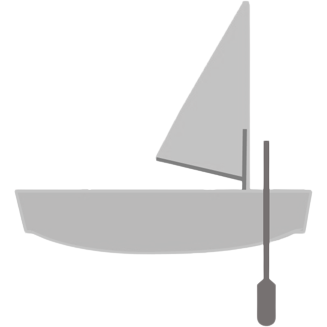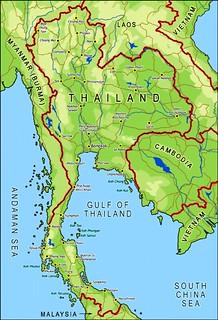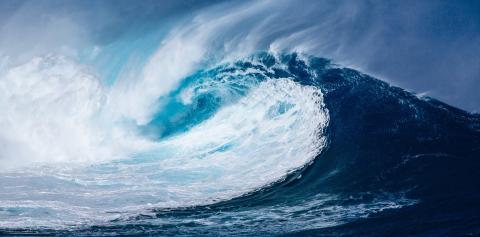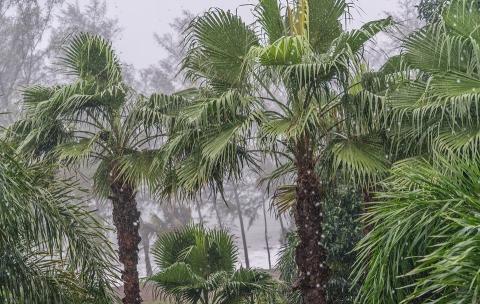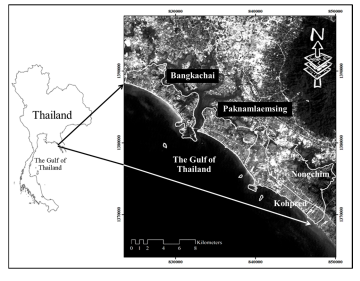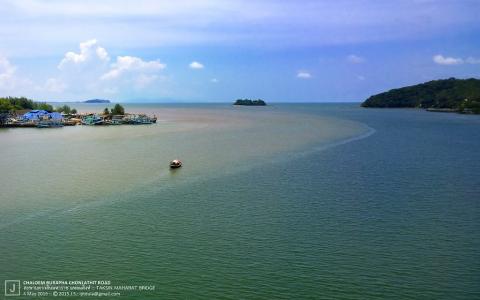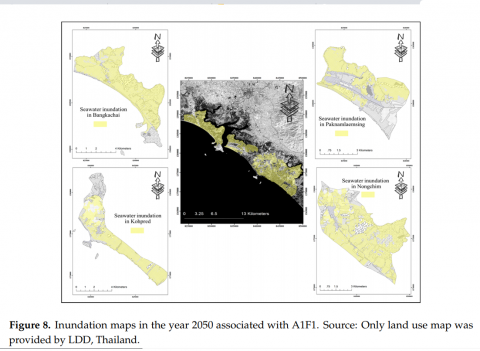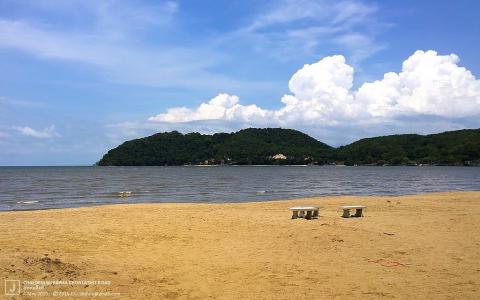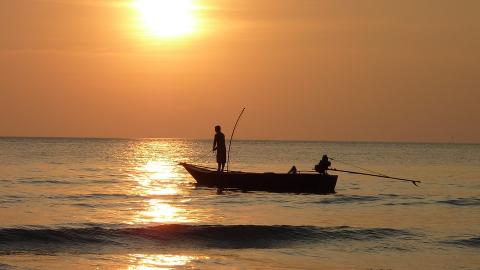Intro
Rising sea levels, increased storm systems, and lack of adaptive capacity threaten Thailand’s livelihood, especially among fishing populations like those of the Laemsing District. The dependence on aquaculture for both nourishment and financial stability should be of great concern to the Thai government. Additionally, the physical vulnerability of coastal villages, like those in Kohpred, Paknamlaemsing, and Bangkachai is very alarming. Even if households could survive the devastation of shrimp ponds and fishing infrastructure, it is unrealistic to assume no lives would be lost from the inundation of the physical household without precautions being put into place. Additionally, nations like Thailand are often excluded from main stream media, making their plight invisible to many.
Geographic Vulnerability and Hazards
Thailand lies in the Inter Tropical Convergence Zone (ITCZ) which produces large amounts of rainfall from mid-May to mid-October and then a dry season from June to July (Apipattanavis et al. 2018). In addition to the flooding from rain, Thailand faces devastating SLR impacts. A World Bank study lists Thailand at number five among the twelve most vulnerable developing nations in terms of rising sea level rise (Dasgupta et al., 2007, p. 29).
In January of 2017, Thailand experienced uncharacteristically high rainfall-- From January 5th to 12th, areas along the Gulf of Thailand received 27.6 inches of rain-- which resulted in flooding and loss of life (Jenner 2017). Thailand is the quintessential environmental dichotomy of water—sometimes it has a deadly excess and sometimes it has a deadly depletion.
Economic Risks
American Dependence:
In 2015, the average American consumed 15.5 pounds of fish and shellfish (NIFA 2018). “Over three fourths of seafood consumed in the U.S. is imported from other countries,” with shrimp accounting for about 33% of these imports and is considered the most important seafood sector import (NIFA 2018). Thailand is the leading supplier of shrimp to the United States (NIFA 2018).
Shrimp Vulnerability:
Panpeng et al. states that based off their 2050 estimates for land indudation due to sea level rise, shrimp ponds will be heavily impacted (2017, p. 11). 65% of the study’s areas are classified as low-lying, which is the preferred location for shrimp ponds (Pangpeng et al., 2017, p. 11). Additionally, in 2008 the Food and Agriculture Administration of the United Nations reported that Thailand’s “penaeid prawn (Penaeus spp.) resources have been over-exploited [and that the] small-sized shrimps (Trachypenaeus spp. and Metapenaeopsis spp.) have also been over-exploited”. These two combined issues make Thailand’s shrimping industry especially vulnerable.
GDP Impact
IPCC research supports that of Dasgupta et al., stating that “the Policy Analysis for the Greenhouse Effect 2002 (PAGE2002) integrated assessment model projects a mean loss of 2.2% of GDP [for Thailand, Indonesia, the Philippines, and Vietnam] by 2100 on an annual basis, if only the market impact (mainly related to agriculture and coastal zones) is considered (ADB, 2009)” (Wong et al., 2014, p.1351). The 2.2% loss is significant in comparison to global average estimation of 0.6% per year by 2100 from market impact only (Wong et al., 2014, p.1351).
Coastal Exposure & Water Overuse
The IPCC states that “coastal systems and low-lying areas will increasingly experience adverse impacts such as submergence, coastal flooding, and coastal erosion due to relative sea level rise (RSLR; very high confidence)” (Wong et al., 2014, p. 364). Thailand, specifically, has 2,624 km of continental coastline and population of 67.96 million (in 2015) (Yenpoeng 2019).
Thailand’s water risks are the most prominent and foreboding. A nation primarily dependent on agricultural practices like rice and shrimp farming, Thailand “consumes 90.4% of its fresh water for agricultural purposes” (Apipattanavis et al. 2018). Apipattanavis et al. compares this statistic to those of “upper-middle- and high-income countries” which are at “67.8 and 40.8% respectively” (2018).
Water Risks and Lack of Adaptive Capacity
Laemsing Impact
Aside from agricultural risks, by 2050, it is estimated 2,060 households will be directly impacted by SLR in Laemsing (Panpeng et al., 2017, p. 12). Anticipated cumulative SLR from 2000-2050 is 50cm (Panpeng et al., 2017, p. 16). Of the four sub-districts examined, it is estimated that they will suffer a total 87.77% loss of land due to water inundation by 2050 (Panpeng et al., 2017, p. 11). Vegetation will also suffer greatly (Panpeng et al., 2017, p.11), which is one of Thailand’s most distinguishing features and marks of physical beauty. One could speculate that the radiant green beaches Thailand is famous for will suffer a decline in tourism as they erode away and the plants disappear.
Image of Laemsing, Chanthaburi Province, Thailand by sundara2557 for Flickr.
Adaptation
Thailand does have a National Adaptation Programme of Action (NAPA) under the United Nations Framework Convention on Climate Change (UNFCCC). In this framework, high-risk coastal communities are a priority, though the government is struggling with developing a more concise plan of action due to lack of research about many of these areas (UNDP 2017). Specifically, more research is desired related to adverse health effects associated with climate change (UNDP 2017).
As listed on the Global Support Programme’s website (UNDP 2017):
“Potential Adaptation Measures [for Thailand]:
Agriculture and Food Security
- Educational & outreach activities to change management practices to those suited to climate change
- Switch to different cultivars
- Develop new crops
Water Resources
- Improve or develop water management
- Alter system operating rules, e.g. pricing policies, legislation
Coastal Zones and Marine Ecosystems
- Develop Integrated Coastal Zone Management
- Develop planning/new investment requirements”
Summary
Continued research and examination of vulnerability and impacts is crucial. South Eastern Asia is a vulnerable area, but once one narrows their focus, one can see the terrifying nature of individual impacts. Every aspect of the lives of many citizens of the Laemsing District and coastal Thailand as a whole are under threat by climate change: their home, their financial stability, their culture through their food, and their livelihood. Failure to take immediate action to prevent land inundation and flooding will almost certainly result in loss of life.
References
ADB, (2009): The Economics of Climate Change in Southeast Asia: A Regional Review. Asian Development Bank (ADB), Manila, Philippines, 255 pp.
Apipattanavis, Somkiat, et al. (2018). “Water Management in Thailand.” The Canadian Journal of Chemical Engineering, Wiley-Blackwell.
Dasgupta, Susmita; Laplante, Benoit; Meisner, Craig; Wheeler, David; Jianping Yan.(2007). The impact of sea level rise on developing countries : a comparative analysis (English). Policy, Research working paper ; no. WPS 4136. Washington, DC: World Bank.
FAO. (2008). Fishing and Aquaculture Country Profiles: The Kingdom of Thailand. The United Nations, Food and Agriculture Organization of the United Nations.
Hijioka, Y., E. Lin, J.J. Pereira, R.T. Corlett, X. Cui, G.E. Insarov, R.D. Lasco, E. Lindgren, and A. Surjan, 2014: Asia. In: Climate Change. (2014): Impacts, Adaptation, and Vulnerability. Part B: Regional Aspects. Contribution of Working Group II to the Fifth Assessment Report of the Intergovernmental Panel on Climate Change [Barros, V.R., C.B. Field, D.J. Dokken, M.D. Mastrandrea, K.J. Mach, T.E. Bilir, M. Chatterjee, K.L. Ebi, Y.O. Estrada, R.C. Genova, B. Girma, E.S. Kissel, A.N. Levy, S. MacCracken, P.R. Mastrandrea, and L.L. White (eds.)]. Cambridge University Press, Cambridge, United Kingdom and New York, NY, USA, pp. 1327-1370.
Jenner, Lynn.(2017). “NASA Analyzes Heavy Rainfall Over Southern Thailand.” NASA, NASA.
National Institute of Food and Agriculture (NIFA), U.S. (2018). Seafood Health Facts: Making Smart Choices, Overview of the Seafood Industry. Retrieved from https://www.seafoodhealthfacts.org/seafood-choices/overview-us-seafood-supply
National Institute of Food and Agriculture (NIFA), U.S. (2018). Seafood Health Facts: Making Smart Choices, Overview of the U.S. Seafood Supply.
Retrieved from https://www.seafoodhealthfacts.org/seafood-choices/overview-us-seafood-supply
McMichael, A.J., P. Wilkinson, R.S. Kovats, S. Pattenden, S. Hajat, B. Armstrong, N. Vajanapoom, E.M. Niciu, H. Mahomed, and C. Kingkeow. (2008): International study of temperature, heat and urban mortality: the ‘ISOTHURM’ project. International Journal of Epidemiology, 37(5), 1121-1131.
Panpeng, Jirwat; Ahmad, Mokbul Morshed. (2017).Vulnerability of Fishing Communities from Sea-Level Change: A Study of Laemsing District in Chanthaburi Province, Thailand. Sustainability. .
Syvitski, James P.M.; Kettner, Albert J.; Overeem, Irina; Hutton, Eric W.H.; Hannon, Mark T.; Brakenridge, Robert G.; Day, John; Vörösmarty, Charles; Saito, Yoshiki; Giosan, Liviu; Nicholls, Robert J.(2009). Sinking deltas due to human activities. Nature Geoscience, Progress Article.
United Nations Development Programme. (2017). Thailand: National Adaptation Global Support Programme. Retrieved from https://www.globalsupportprogramme.org/explore/south-eastern-asia/thailand
Wong, P.P., I.J. Losada, J.-P. Gattuso, J. Hinkel, A. Khattabi, K.L. McInnes, Y. Saito, and A. Sallenger, 2014: Coastal systems and low-lying areas. In: Climate Change (2014): Impacts, Adaptation, and Vulnerability. Part A: Global and Sectoral Aspects. Contribution of Working Group II to the Fifth Assessment Report of the Intergovernmental Panel on Climate Change [Field, C.B., V.R. Barros, D.J. Dokken, K.J. Mach, M.D. Mastrandrea, T.E. Bilir, M. Chatterjee, K.L. Ebi, Y.O. Estrada, R.C. Genova, B. Girma, E.S. Kissel, A.N. Levy, S. MacCracken, P.R. Mastrandrea, and L.L. White (eds.)]. Cambridge University Press, Cambridge, United Kingdom and New York, NY, USA, pp. 361-409.
Wassmann, R., S.V.K. Jagadish, S. Heuer, A. Ismail, E. Redona, R. Serraj, R.K. Singh, G. Howell, H. Pathak, and K. Sumfleth. (2009a): climate change affecting rice production: the physiological and agronomic basis for possible adaptation strategies. In: Advances in Agronomy, Vol. 101 [Sparks, D.L. (ed.)]. Academic Press, Burlington, MA, USA, pp. 59-122.
Wassmann, R., S.V.K. Jagadish, K. Sumfleth, H. Pathak, G. Howell, A. Ismail, R. Serraj, E. Redona, R.K. Singh, and S. Heuer, (2009b): Regional vulnerability of climate change impacts on Asian rice production and scope for adaptation. In: Advances in Agronomy, Vol. 102[Sparks, D.L. (ed.)]. Academic Press, Burlington, MA, USA, pp. 91-133.
Yenpoeng, Thana. (2019). Fisheries Country Profile: Thailand. SEAFDEC, Southeast Asian Fisheries Development Center.
Images:
Banner Image: by Pongdanai for Pixabay
Fishing Village Image: Koh Panyee Island Floating Fishing Village Thailand, by Maria Michelle
Shrimp Image by Robert Owen Wahl for Pixabay
Boys in boat in flooded Bangkok street by terimakasih0 for Pixabay
Portrait of Sarah Brock taken by St. Lawrence University Rowing
